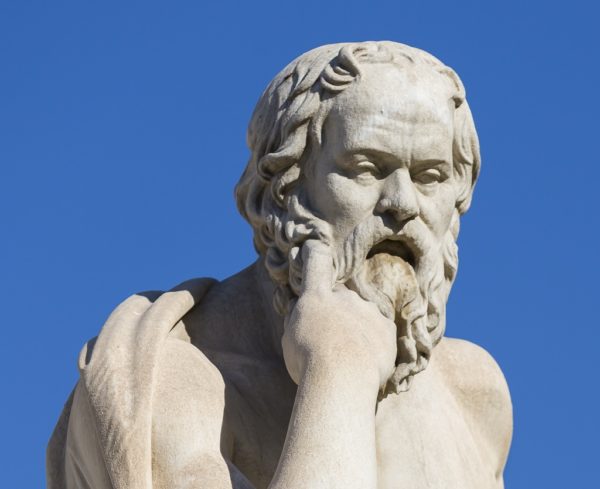Understanding The Socratic Method
You will never successfully have a debate on the internet. At best, you will become one of several actors pantomiming abstract ideas so that an audience can pass judgment. What you can do, instead, is to use pointed questioning to trace thoughts to their roots, and in doing so, subvert illusions and assert realities.
This approach is called The Socratic Method, and it is the root of Western thinking. The important part is not the question-and-answer format, but the tendency to look at cause/effect relationships, and to trace back through a chain of them to figure out why people think certain things are true and how we can verify them.
Unlike empiricism and “logical positivism,” this line of thinking applies even to abstractions that cannot be materially tested. This union between abstraction and realism through cause/effect thinking is the backbone of The Socratic Method:
Socrates describes himself not as a teacher but as an ignorant inquirer, and the series of questions he asks are designed to show that the principal question he raises (for example, “What is piety?â€) is one to which his interlocutor has no adequate answer. Typically, the interlocutor is led, by a series of supplementary questions, to see that he must withdraw the answer he at first gave to Socrates’ principal question, because that answer falls afoul of the other answers he has given. The method employed by Socrates, in other words, is a strategy for showing that the interlocutor’s several answers do not fit together as a group, thus revealing to the interlocutor his own poor grasp of the concepts under discussion.
(Euthyphro, for example, in the dialogue named after him, having been asked what piety is, replies that it is whatever is “dear to the gods.†Socrates continues to probe, and the ensuing give-and-take can be summarized as follows: Socrates: Are piety and impiety opposites? Euthyphro: Yes. Socrates: Are the gods in disagreement with each other about what is good, what is just, and so on? Euthyphro: Yes. Socrates: So the very same actions are loved by some gods and hated by others? Euthyphro: Yes. Socrates: So those same actions are both pious and impious? Euthyphro: Yes.)
The interlocutor, having been refuted by means of premises he himself has agreed to, is free to propose a new answer to Socrates’ principal question; or another conversational partner, who has been listening to the preceding dialogue, is allowed to take his place. But although the new answers proposed to Socrates’ principal question avoid the errors revealed in the preceding cross-examination, fresh difficulties are uncovered, and in the end the “ignorance†of Socrates is revealed as a kind of wisdom, whereas the interlocutors are implicitly criticized for failing to recognize their ignorance.
The Socratic Method leads to a positive approach: instead of trying to demonstrate a consistent relationship between linear parts, it looks for a recurring pattern that causes the final state which we interpret as the result of a linear cause.
It explores this by essentially asking what the cause of any particular element is, and then comparing that to the larger question of purpose. This results in getting to the core of any idea without allowing method or appearance to get in the way of structure, or how it interacts with other ideas and reality as a whole.
At the heart of this is the spirit of the West, which is an unrelenting pursuit of order, beauty, excellence, goodness, truth, and exact answers. Where most philosophy is merely categorical, The Socratic Method inverts categories and discovers pattern orders instead.
Tags: philosophy, plato, socrates, socratic method










